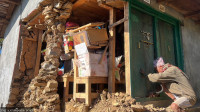Opinion
Dealing with donors
The upcoming donor conference will be instrumental in planning Nepal’s long-term reconstruction
Som P. Pudasaini
Nepal is grappling with a colossal loss of life, property, and livelihood resulting from the powerful 7.9 magnitude earthquake of April 25 and the hundreds of big and small aftershocks since then.
Search and rescue and relief were conducted with variable success and a lot of disappointment. Nepal is now at the threshold of moving on to rehabilitation and reconstruction, which will need a sound plan, effective organisation, good management, and coordination. The challenge is big. Additional resources will have to be mobilised and effectively utilised. Continued support from the government, the private sector, NGOs, and civil society will be needed at large scales for the years to come.
Human suffering and natural disasters are shared responsibilities of all human beings and nations. They have no political boundaries. The outpouring of sympathy, help in search and relief in the aftermath of devastation from within the country and across the continents is testimony that human decency is alive and kicking. Nepal is gearing up to raise additional resources for the long and costly process of rehabilitation and reconstruction. The international community has been invited to chip-in for reconstruction, expected to cost up to $10 billion, almost 50 percent of Nepal’s GDP.
A more rigorous assessment promised by the government is likely to provide a more accurate picture of damages and the cost in a few weeks’ time. The government has planned a donor conference to seek support for reconstruction for June 25, before the government submits its budget in July for the Fiscal Year 2015/16. In this context, four points that the government and key donors seem to be occupied with may be worth discussing here.
Needs and a plan
First, what is the total resource need and what is the resource gap that needs to be supplemented by external resources? The government’s initial rough estimation of $5-10 billion total needs requires a thorough re-calculation based on the assessment that it has promised. Also, it must conduct a realistic estimation of how much internal resources will be generated and can be expended every year. Then, come up with a figure of the total resource gap and what is justified to be met by external resources in a time-bound manner.
Second, where is a realistic and time-bound rehabilitation and reconstruction plan for the conference to deliberate on? Also, rehabilitation and reconstruction work must be prioritised and phased out properly to be effective, rather than rushed in an ad hoc manner.
The location
Third, the government has now decided to organise the donor conference in two phases, after an initial confusion. The first conference will be organised by the Government of Nepal itself and in Kathmandu on June 25. This will be largely held with participation by organisations based in Kathmandu. It will discuss general needs for reconstruction, based on preliminary findings of the government’s post-disaster needs assessment currently underway. A more elaborate donor meeting will then be organised in September to mobilise additional resources for medium and long-term rehabilitation and reconstruction after preparing a detailed plan in the subsequent months.
The September meeting could be organised outside Kathmandu, with strong collaboration with key donors in the neighbourhood. The key concern is that Nepal must have adequate control over its need and plan during the discussion and the final agreement. Obviously, everyone’s goodwill must be tapped. But, mutual interest, willingness, and capacity to fund must be considered seriously before offering a prominent role to one or the other donors interested in being active co-organisers.
Fourth, where is an effective institutional arrangement and national capacity for the implementation of the reconstruction plan? Implementation has been a big issue for us and donors for a long time. Integrity and honesty of a large section of the political and bureaucratic leadership is a continuing issue in the minds of locals and donors alike. In addition, the lack of an effective institutional arrangement to deal with natural disasters—earthquakes, floods, or river blockades—is a glaring lacunae. While all the institutional, management, coordination, and a host of good governance issues must be tackled quickly, it is not possible to deal with them all immediately and in this hour of disaster.
However, the establishment of the autonomous Natural Disaster Management Authority, headed by a qualified and non-too-politicised professional, is a must, as experiences from India, Pakistan, and Indonesia testify. The All-Party Mechanism preferred by politicians has failed in the past and is seen to be too corrupt and partisan by locals and donors to be trusted with this task. However, the autonomous authority must be fully supported and guided honestly by the top political leadership to succeed.
And additionally
Four additional points must be added here. First, the donors’ own performance is far from glorious in Nepal and elsewhere. Consequently, the donors and their agencies must enhance their performance. They must also respect and help strengthen local leadership and capacity, rather than overwhelm them.
Second, the government’s desire for a ‘one- window’ policy is good thinking for the longer run. Its capacity and trust deficit is too big to be bridged immediately. Consequently, competent and well-established national and international organisations must be allowed to implement programmes under its coordination and guidance. It can assign location and task-specific rehabilitation and reconstruction work in a time bound manner. A monitoring and evaluation mechanism must be built within the Disaster Management Authority to assess the government’s and local and international partners’ performance and devise corrective measures.
Third, local communities’ participation and empowerment is a must for sustainable and effective programmes.
Fourth, strong zeal and commitment demonstrated by young people during the aftermath of the earthquake must be effectively tapped and coordinated in reconstruction.
Additionally, international campaigners and the Nepal government are seeking relief of $3.8 billion foreign debt. This was done, for example, for Haiti in the aftermath of the earthquake and for African countries following the Ebola outbreak. Nepal made “$217 million in external debt payments in 2013, or nearly $ 600,000 a day,” according to The Kathmandu Post. It is argued that debt relief would releases Rs 20-30 billion per year for reconstruction and long-term stability. A flexible debt sustainability analysis and compassionate approach by key loaners—the World Bank, Asian Development Bank, International Monetary Fund, Japan, and China—can lead to an agreement on debt relief during the conference.
Finally, political leaders can help burnish Nepal’s image and reduce the trust deficit in the eyes of locals and donors if the never-ending political transition, the absence of elected local representatives, pervasive corruption, and constitution writing are dealt with simultaneously while the world is eager to help and the people are ready to reconstruct and build a better life in the aftermath of the devastating earthquake.
Pudasaini is a former UNFPA Representative in Sri Lanka and Yemen and former UNFPA Country Director for the Maldives ([email protected])




 15.12°C Kathmandu
15.12°C Kathmandu










